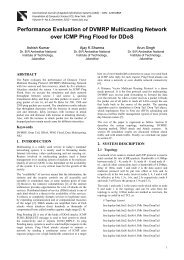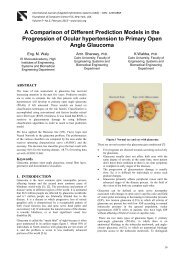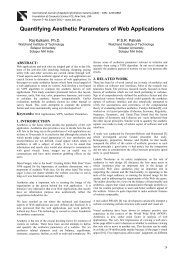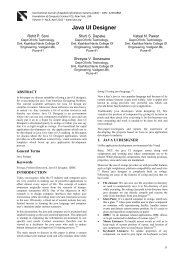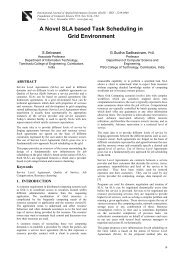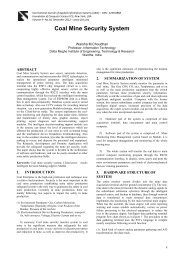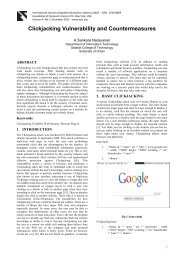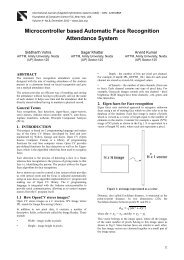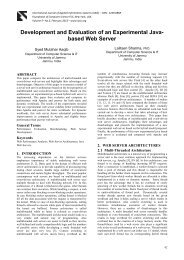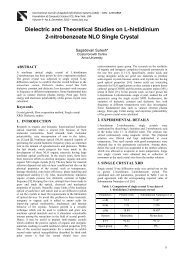Proposed Negative Ion Generator - International Journal of Applied ...
Proposed Negative Ion Generator - International Journal of Applied ...
Proposed Negative Ion Generator - International Journal of Applied ...
Create successful ePaper yourself
Turn your PDF publications into a flip-book with our unique Google optimized e-Paper software.
<strong>International</strong> <strong>Journal</strong> <strong>of</strong> <strong>Applied</strong> Information Systems (IJAIS) – ISSN : 2249-0868<br />
Foundation <strong>of</strong> Computer Science FCS, New York, USA<br />
Volume 3– No.8, August 2012 – www.ijais.org<br />
With above mentioned drawbacks to achieve the objective,<br />
help <strong>of</strong> suitable s<strong>of</strong>tware such as COMSOL multiphysics is<br />
used. This s<strong>of</strong>tware performs equation based multiphysics<br />
modeling for different physical process by applying partial<br />
differential equations [9]. Relevant equations to the objective<br />
have studied.<br />
Governing equations for electro hydrodynamic flow induced<br />
by corona discharge is described as follows,<br />
The electric potential V in air is governed by the Poisson’s<br />
equation which is given by:<br />
Where q -space charge density,<br />
⁄ … (1)<br />
ϵ0 - dielectric permittivity <strong>of</strong> free space.<br />
The electric potential is defined from electric field intensity E<br />
as<br />
… (2)<br />
Electric current in the drifting zone is a combination <strong>of</strong> three<br />
effects<br />
- Conduction (motion <strong>of</strong> ions under electric relative to entire<br />
airflow)<br />
- Convection (transport <strong>of</strong> charges with airflow)<br />
- Diffusion<br />
Therefore current density is given by<br />
Where μEq - the air ions mobility in an electric field<br />
Uq - Velocity vector <strong>of</strong> airflow<br />
D - Diffusivity coefficient <strong>of</strong> ions<br />
Q – Charge <strong>of</strong> Electron<br />
… (3)<br />
Current continuity condition gives equation for current<br />
density<br />
… (4)<br />
Hydrodynamic part <strong>of</strong> the problem is described by Navier-<br />
Strokes equations and continuity equation for steady state<br />
incompressible air flow<br />
Where ρ-air density<br />
p - Air pressure<br />
μ - Air dynamic viscosity<br />
… (5)<br />
… (6)<br />
Combining all we can obtain the following charge transport<br />
equation.<br />
( … (7)<br />
Thus, electro hydrodynamic flow for model is described by<br />
system <strong>of</strong> equations with appropriate boundary conditions to<br />
apply for simulation and for the shape <strong>of</strong> the model.<br />
The gap between corona and collecting electrodes can be<br />
divided into two regions, the ionization and drift zones.<br />
By trying different permutation and combination on<br />
dimensions <strong>of</strong> shield, spacing between emitter and extractor<br />
and by different combination <strong>of</strong> voltages applied to emitter<br />
and extractor. The model <strong>of</strong> ion transponder is finalized with<br />
following shape and specifications.<br />
Table 2. Dimensions <strong>of</strong> the Model<br />
PARAMETER SHIELD EMITTER EXTRACTOR<br />
LENGTH (mm) 338.05 270.44 270.44<br />
DIAMETER (mm) 3 0.05 2<br />
A. Number <strong>of</strong> electrodes used: 3<br />
B. Shape <strong>of</strong> electrodes: Trapezoidal (basket).<br />
C. Material used for all electrodes: Stainless steel<br />
D. Distance between horizontal conductors: 67.61mm<br />
E. Angle <strong>of</strong> with respect to ground: Variable.<br />
Fig.3: <strong>Ion</strong> transponder<br />
Fig.4: Estimation <strong>of</strong> specifications<br />
46



